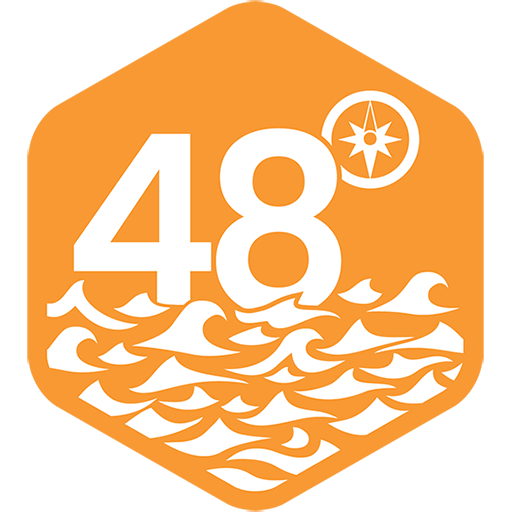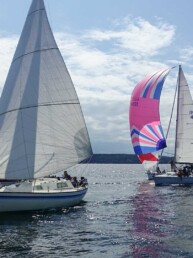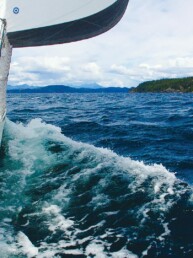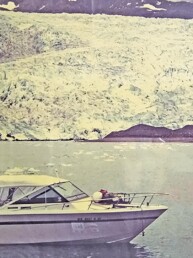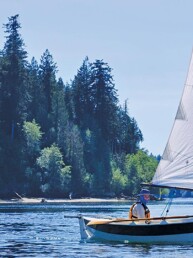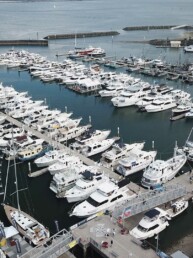In early August, 48° North put on a new cruising rally, which was sponsored by Ullman Sails. A terrific group of people enjoyed and a week of tropical weather while we cruised together through the San Juan and Gulf Islands. Simply put, the experience was tremendous – so fun and fulfilling – exceeding my expectations in every way.
The idea to start a new rally began at the Seattle Boat Show two years ago, and became a reality at this year’s show. Chuck Skewes, of Ullman Sails, and I saw an opportunity for a community event that could also be a cool resource to sailors.
From the earliest discussions to the actual implementation of the rally, the vision was surprisingly clear: create a rally that will be accessible to folks newer to cruising while still being fun for very experienced sailors; facilitate opportunities for new experiences and increased skills, knowledge, and cruising confidence; connect sailors of varying backgrounds, strengthening the cruising community in the Pacific Northwest.
With that mission in mind, we set about planning and promoting the first annual Cascadia Cruising Rally. Since there are already successful rallies that help sailors get offshore safely (Coho Ho Ho, and the Baja Ha Ha), an early decision was to stay comparatively local. This wasn’t a hard call – we have some of the world’s finest cruising grounds right in our backyard (a claim I’ve never been more sure of than after this year’s rally). However, we still wanted to encourage people to get outside of their comfort zones. So for this first year, we decided that the pillars of the rally would be crossing the border to cruise the Canadian Gulf Islands, and encouraging participants to anchor out most, if not all, nights.

The Cascadia Cruising Rally itinerary took shape, starting and ending in Anacortes. Our trip would involve one night in the San Juans and four nights in the Gulf Islands. In the interest of exploration and relaxation, we chose three destinations for our five nights out, allowing for two layover days. At every turn, we made an effort to remind ourselves and our participants that you can’t lock in an itinerary; that conditions and prudence can overrule even a good plan. Nonetheless, as luck would have it, we were able to keep to our Plan A itinerary without issue: Anacortes to West Sound (1 night), West Sound to Bedwell Harbour (2 nights), Bedwell Harbour to Winter Cove (2 nights), and then from Winter Cove back to Anacortes.
While weather can be variable, the true unknown with the inaugural rally was who would come? Slowly but surely, registrations started trickling in. What we know now, that we didn’t know as we planned it, is that we hit the participant jackpot. The crew that showed up and trusted us while we tried something new turned out to be some of the finest folks I’ve encountered in sailing. (Get to know them on page 30). Each boat and each sailor brought a unique background, but together the group was remarkably cohesive. It speaks volumes that this group was willing to take a chance on us during this proof-of-concept run. Their positivity, knowledge, and prudence made our jobs as leaders easy and enjoyable.

The rally participants made their own way to Anacortes, and for several, that alone was a multi-day trip. The Rally mind-meld was already on display even in preparation for that trip. Participants asked for advice about getting there, and it was a good opportunity to highlight the merits (and risks) of the approach to Anacortes via the Strait of Juan de Fuca, Deception Pass, or the Swinomish Slough.
To everyone’s credit, each boat made it to Anacortes without mishap, though not without challenges of long days or fog (more on that pea soup stuff later…). Arriving at Cap Sante has always felt good to me, and this trip was no different. If there’s a cleaner or better-kept marina in the Salish Sea, I’m not aware of it. From the Cap Sante staff’s assistance reserving slips for our rally to the ‘Thank You’ postcards they hand deliver to the boats, it’s a very hospitable place!
With all of our boats and participants in town, the rally week officially kicked off with the Ullman Sails crew – which consisted of Chuck and Sabine Suessmann from Ullman Sails San Diego and Puerto Vallarta, and Vince Townrow of Ullman Sails Seattle – wining and dining us at their expansive loft located a short walk from the marina. They grilled steak and salmon and veggies, and the Dark ‘n’ Stormy was the refreshment of choice (as it would be all week).
After dinner, Chuck and I ran a brief pre-trip meeting and we all sat in a circle and did some get-to-know-you stuff. Both 48° North and Ullman sails gave away some sweet swag along with the skippers’ packets and the Rally Goer’s Guide document. After a fun night, everybody turned in at a reasonable hour, knowing there was a big week ahead.
On Day One (we called the kick-off party Day Zero), we awoke to the weather that we’d have most of the week, blue skies, sun, heat, and little-to-no wind. Tucked in behind the hook in Fidalgo Bay, we could not see the fog that awaited us in Rosario Strait.
A cool tradition developed during this first year of the Cascadia Cruising Rally – each travel day started with a hosted coffee-hour debrief aboard the Rally HQ boat, S/V Blackbird. It was a fun way to connect, consider the navigation and weather information for that day, and think about our next destination. Squeezed into our cabin, sipping our coffee, we talked through currents in Guemes Channel, ferry traffic in Thatcher Pass, and an anchoring plan in West Sound.
That first day, we added a seventh boat to our armada. Vince Townrow had use of a J/105 and decided to join us for the trip to West Sound. Since he was sailing solo, he invited me to join him. I was happy to do so, since Chuck and Sabine were more than capable of cruising Blackbird without me. Plus, I figured there was more chance of making miles under sail on the more performance-oriented design, given the light breeze.
We rigged up and motored carefree toward Rosario Strait. Before we saw it, we heard on the VHF that Rosario was socked in. On a rally like this, each skipper must make his or her own decisions for the safety of their boat and crew. However, there can be safety in numbers, and a prudent sailor may take advantage of their rally colleagues’ experience or equipment. The first three boats in the rally headed into the fog nearby one another. The lead boat, True North, soon heard a too-close-for-comfort fog horn. They quickly turned around and tucked in behind Blackbird, which is set-up with radar. Though the visibility was bad, True North, Commander, and Blackbird, stayed within sight of each other all the way across Rosario and safely through Thatcher Pass.
While several others made the wise choice to wait out the fog (and were rewarded with a lovely sunny sail across Rosario), Vince and I downloaded an AIS app, turned on multiple GPS units, and headed into the soup. We were actually able to sail through the first portion of fog. It was startling when the breeze died, neither one of us could maintain a semblance of a straight course.
To give a wide berth to any unseen traffic, we skirted northwest of Lawson Rock before ducking through Thatcher Pass. As we transited the pass into the islands, we immediately sailed completely out of the fog and into sun and a bit a breeze. Up went the kite, and we finished most of our miles under spinnaker.

We sailed into West Sound, downwind in a southerly. While this was exciting, it made me slightly nervous about the overnight anchorage since West Sound has a reputation for southerlies that make your night uncomfortable or your well-set anchor insecure. But as we made our way past the hazard at Harbor Rock and into Massacre Bay, the breeze lightened, as it would stay for the rest of the night. Just for the practice of it, we anchored under sail. The hook bit on the first try and we were set.
Those who waited out the fog arrived only an hour later, grinning after a great sail.
West Sound is just gorgeous, and several of our crew went ashore to explore Skull Island State Park. The macabre names of Massacre Bay and Skull Island come from a bloody raid on the local Lummi villagers in this bay by the Haida nation from the north.
As an anchorage, we found it to be better than expected. The southerly stayed further out in the bay, we all anchored in about 25 feet of mud with swing room, and there were only two non-rally boats in the anchorage. Nice!

A highlight of our stop in West Sound was a gathering on Blackbird so that Chuck could give a seminar on sail trim, which was peppered with many gripping stories of boat racing on the open ocean.
We awoke for our second travel day to more blissful, summer conditions. Again, we gathered on Blackbird for coffee and a briefing. We considered the best route out of Harney Channel, Pole Pass or Wasp Passage. Though Wasp has more options, it also has more hazards. We decided that, especially with positive current, Pole Pass was our choice.
Underway, we waited for a large powerboat to vacate the pass before we entered; then we went through Pole Pass like a drill team, perfectly spaced in line, as if we’d practiced. It was low stress with four knots of current push.
The rest of the travel day was pleasant and uneventful. We made quick work of 16 miles with negligible current and glassy waters. If you have make miles with the engine, it’s nice if there’s no breeze at all… even the lightest breeze tempts me into a seldom-effective try with the sails up.
In no time, we were entering Bedwell Harbour and preparing to clear customs. This had been a source of major discussion before the rally. It is difficult to accurately interpret what food, especially fruits and vegetables, you may bring into Canada from Washington. Most of our cruisers chose not to bring anything. We had some lettuce and carrots, bananas and limes. I can’t say declaratively why, but these did not cause us a problem. In fact, the agent asked whether they were for eating, which of course the were, and that put the inquiry to bed.
All Cascadia Cruising Rally boats passed the border clearance test with flying colors, and the four boats that intended to anchor made a bee-line for Medicine Beach on the far north end of the bay. The others had arranged for spots at the resort marina. I had read some things about a nice anchorage up by Medicine Beach: good bottom, a sandy beach, an unusual saltwater marsh ecosystem, and there’s even some basic shore-side amenities (liquor store and pizza place).
For the second time in as many days, we found a lovely, placid anchorage without a crowd. We pulled in and trolled a little bit for depth and the right spot. While the whole area inside (northwest) of the charted kelp and rocks is anchorable with depths between 20 and 30 feet, we dropped the hook off of Blackbird twice without a bite. It’s hard to say whether we were over a rocky shelf or whether it was a dense carpet of kelp that kept our anchor from finding paydirt, but we were zero-for-two. In the meantime, just a little ways due west of us, Commander got a solid set on their first try. Since they’re a heavy boat fit out with a big anchor and lots of chain, we just decided to raft up to them. Just east of us, Peter also had success on his first anchoring attempt on Engadine. We were just unlucky, I guess.
Eventually, Eagle Spirit joined our raft-up after a little trouble with their windlass, which skipper Bill from Commander quickly helped them fix.
It was hot. I took a quick dip, and was pleased to find that the water wasn’t gasp-inducingly cold. Commander’s water temperature gauge measured 61°F. That’s balmy for these parts!

Chuck, Sabine, and I took the dinghy to Medicine Beach to explore and to resolve an ongoing debate about whether to call the store just up the hill in Medicine Beach a convenience store or a grocery store. Result: it’s definitely more of a convenience store, but we did buy a fresh red pepper from their small produce cooler. So, the debate continues. We also picked some blackberries and walked the short hiking trail up the hill overlooking the beach.
The late afternoon heat brought the Pender Islanders down to the beach to swim. Different groups were inflating all manner of floatable toy, and multiple generations immersed themselves in the clear, warm-ish water.
That evening, we dinghied back across the harbor to enjoy a full group meal ashore at Syrens Pub at Poet’s Cove Resort. The patio was perfect, the service attentive, the food delicious and the sunset stunning. This was the life.
Day Three was our first of two layover days, and we were all eager to make use of it. Six of us (in three dinghies) made for Beaumont Marine Park on the east shore of Bedwell Harbour to hike to the top of Mount Norman. Meanwhile, the combined crews of Commander and True North headed through the Pender Canal over to Port Browning to provision.

The hiking group slogged up and up in the heat. Several times, we incorrectly thought we were close to the top. In fact, we took a couple of wrong turns because we’d been following a trail guide that started at a parking lot, not at the beach. Before long, I was downloading another app (a trails app this time, but you may be sensing a trend) and we discovered that the hike was a tad longer than we had read.
By the time we crested the top and found the observation platform, we had truly earned the breathtaking panoramic views of the San Juans, Gulf Islands, and the jagged shoreline of Vancouver Island.
After the hike, we headed back to luxurious Poet’s Cove. As the “guests” of our friends who were actual guests at the resort, we enjoyed the pool and got a shower.
Then, it was our turn to explore the Pender Canal and check out Port Browning. The canal is man-made and has a 26’ bridge, so it was a dinghy-only excursion. The the trip through the canal is beautiful and unique, and Port Browning is nothing if not charming. Additionally, the grocery store there is magnificent. Ten minutes of walking from the dock brings you to a fabulous development with everything from a visitor center to a fitness club. And, what we were looking for… fruits and veggies.
We headed back trough the canal, pausing to enjoy the show of a family jumping into the water from the bridge. Back at the boats, we gathered on Eagle Spirit for an impromptu potluck, and found ourselves trading stories of our greatest adventures. It’s a good thing we were pretty much the only ones in the anchorage, otherwise our laughter late into the night might have disturbed our neighbors.
Day Four dawned with, you guessed it, more heat and sun. Since it was a travel day, we had our coffee hour briefing, and specifically looked at Minx Reef, which guards the entrance to that afternoon’s destination, Winter Cove. It’s not necessarily hazardous if you go wide around it, but it could be severely troublesome if you weren’t careful about it.
That day, I decided to sail with our single-hander, Peter Knudson, on his new-to-him Saga 35. Like me, Peter is originally a Minnesota boy, and we share elements of a common history. As we bid adieu to Bedwell Harbour, we realized we had frequented the same lakeside haunts back in the Midwest.
We had never sailed together before, but we fell into a natural team dynamic. At essentially the same moment entering Plumper Sound, we looked at each other, and then at the masthead, and then back at each other… “We’ve got breeze, let’s go sailing!” Busying ourselves with the enjoyable work of rigging up, we were soon broad reaching at the same speed we’d been motoring. The Saga is a Perry design and, true to his line, performed impressively in the light-to-moderate air. Our rally pals moved on ahead, motoring on rhumb line, but we were cruising under sail! Peter, in particular, was ebullient. He doesn’t have that many days actually sailing his new boat, and to experience his boat in that place in that weather – he was living the dream.
By the time we made it into Winter Cove, Blackbird had a solid set for a full-group raft-up. All six boats tied together, and we relaxed into our new home.

Before long, the itch to discover needed a scratch and we first dinghied, and then went ashore, to check out Boat Pass. A narrow and roiling cut from Winter Cove into the Strait of Georgia, boat pass is intimidating, but passable for fast, shallow-draft boats. Several of us admitted that when a fishing boat made for the pass at 20 knots, our thoughts ranged from, “no, no, no” to “nice knowin’ you, dumbass.” The fishing boat transited just fine.
That first night in Winter Cove was Music Night. Agnes from True North and I set up shop in the cockpit of her boat, along with Wayne Gilham, a special guest from a non-rally boat playing some kind of dulcimer. We played a mix of crowd-pleasers and a little obscure stuff over the course of an hour. I know we had fun. Our rally friends gathered on Blackbird while this was happening and seemed to enjoy themselves too. I’ll tell you this – Janis Joplin ain’t got nothin’ on Agnes!
Our final layover day had two key features – a long trip to the Lighthouse Pub and a fresh anchoring challenge.
The entire group, by foot or dinghy, met for lunch over at the lovely pub at Saturna Point. The walking group enjoyed a 12km amble through the picturesque countryside, which was accented with roadside blackberry picking sessions.

We shared a hearty meal and started to reflect on the good times we’d had this week with our new cruising friends. It had the feeling of a warm, fuzzy denouement. Little did we know that our story had one final twist (literally).
Since we were leaving six boats rafted together before our lunch excursion, we set a second windward anchor as well as a stern anchor to keep the raft from spinning and fouling the bow anchors.
Despite these efforts, we returned from lunch to find the raft 180° from where we left it. We set about unwinding and un-fouling. Before long, we were set on a single, un-fouled hook oriented to the building southerly breeze.
However, as that new breeze built, our six-boat raft proved too much for the single Bruce anchor. To our own consternation and the worry of the other boats around us, we began to drag. We motored the raft forward and re-set two anchors. Now, we were holding again.
The breeze came and went and the current pumped and swirled. All the while the raft swung, never finding a steady orientation.
We gathered for one final potluck aboard Blackbird, toasted one another for the wonderful week, and gave away a few thank-you prizes. But before the light was gone, we decided that the conditions were too inconsistent for another night rafted up. We broke up the raft and anchored individually around Winter Cove. Other than making the safe choice, the best part of this call was the occasion to be out in the dinghy after dark to see the magical bioluminescence.

The last day of the rally was our longest travel day – 33 miles from Winter Cove back to Cap Sante. To make matters worse, our progress was slowed by stronger opposing currents than we anticipated in the morning, and thus we spent more time late in the day fighting the flood as we made our way down Rosario Strait. On the bright side, we got some great sailing in during the morning hours, and the surroundings are just too beautiful to be very upset about a longer-than-predicted trip.
Two of our six boats continued cruising to other destinations, but the four boats who were supposed to make it back to Cap Sante eventually did. The Ullman Sails crew treated us to one more meal. We hugged our new rally friends like the cruising family we now were, and went our separate ways.
Looking back on this first annual Cascadia Cruising Rally, I’m incredibly happy about, and proud of, the outcome. From all parties, good feelings and satisfaction abound. Every participant asked us about next year, and Chuck and I already have plans in the works. This fun new tradition is here to stay, and ready for more of you to join us in 2019!
I’d like to extend a very special thank you to a few folks: thank to Chuck and Sabine from Ullman Sails for their time and effort as my partners in rally crime; also I owe a huge debt of gratitude to Roy Rard for the use of his sturdy and luxurious CS40, “Blackbird” as the Rally HQ boat.
Joe Cline is the Editor of 48° North.
Photos by Lyn Rackley, Chris Doutre, and Joe Cline.
Joe Cline
Joe Cline has been the Managing Editor of 48° North since 2014. From his career to his volunteer leadership in the marine industry, from racing sailboats large and small to his discovery of Pacific Northwest cruising —Joe is as sail-smitten as they come. Joe and his wife, Kaylin, welcomed a baby girl to their family in December 2021, and he is enjoying fatherhood while still finding time to sail, make music, and tip back a tasty IPA every now and again.
